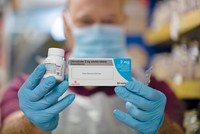Advertisement
Grab your lab coat. Let's get started
Welcome!
Welcome!
Create an account below to get 6 C&EN articles per month, receive newsletters and more - all free.
It seems this is your first time logging in online. Please enter the following information to continue.
As an ACS member you automatically get access to this site. All we need is few more details to create your reading experience.
Not you? Sign in with a different account.
Not you? Sign in with a different account.
ERROR 1
ERROR 1
ERROR 2
ERROR 2
ERROR 2
ERROR 2
ERROR 2
Password and Confirm password must match.
If you have an ACS member number, please enter it here so we can link this account to your membership. (optional)
ERROR 2
ACS values your privacy. By submitting your information, you are gaining access to C&EN and subscribing to our weekly newsletter. We use the information you provide to make your reading experience better, and we will never sell your data to third party members.
Infectious disease
Covid-19
FDA grants emergency use authorization for convalescent plasma in COVID-19
Move widens access to a therapy that many feel has modest efficacy at best
by Lisa M. Jarvis
August 27, 2020
| A version of this story appeared in
Volume 98, Issue 33

The US Food and Drug Administration has granted an emergency use authorization (EUA) to convalescent plasma, a product derived from the blood of people who have recovered from COVID-19. Although not a full approval, the EUA makes it easier for doctors to administer plasma.
The move was swiftly criticized after FDA commissioner Stephen Hahn misstated the benefits of plasma in a press conference led by President Donald J. Trump to announce the EUA. Hahn said that if plasma were given to 100 people sick with COVID-19, “35 would be saved.” Trump called the therapy a “breakthrough.”
Support nonprofit science journalism
C&EN has made this story and all of its coverage of the coronavirus epidemic freely available during the outbreak to keep the public informed. To support us:
Donate Join Subscribe
That number was a relative rather than an absolute benefit, Hahn later clarified. In a subset of COVID-19 patients, those given a high dose of plasma, which contains more virus-fighting antibodies, were 35% more likely to survive than similar patients given a low dose.
Doctors in the thick of the pandemic are frustrated that the top FDA official sent mixed messages and that the data supporting the EUA were based on trials lacking a placebo arm. “This kind of black and white statement really complicates my job as a scientific communicator, because there are significant gray areas here,” Philippe Bégin, a doctor leading a convalescent plasma trial at CHU Sainte-Justine, said in an email to C&EN. “Instead of presenting a balanced vision of a therapy which I do feel excited about and think probably works (although it remains to be shown properly), now I have to argue against it and focus on the limits.”
Some infectious disease experts say the takeaway is that many plasma studies suggest it is safe and works for some people. “The available information is encouraging that this is reducing mortality, even though doctors would like much greater certainty,” says Arturo Casadevall, an immunologist at Johns Hopkins Bloomberg School of Public Health who led an expanded access program for plasma, coordinated by the Mayo Clinic, that enrolled over 101,000 patients.
In addition, Casadevall says, the EUA means that access to plasma will be more equitable. Although any doctor could previously ask for plasma, doing so required registering patients and informing the FDA and Mayo of the outcome. “If you have a well-staffed hospital, that’s a minor inconvenience,” Casadevall says. “But if you are in a hospital in a surge region or an understaffed hospital, that is a significant commitment of resources.” Now, anyone can prescribe plasma.
Although convalescent plasma has the advantage of being cheap and available soon after an outbreak, what patients get and how well it might work is highly variable. “The plasma comes from a donor,” says Erica Ollmann Saphire, an immunologist at the La Jolla Institute for Immunology. “The donor may or may not have had a super-strong response, and in that response there’s a lot of antibodies—some are good, some are not.”
While not the breakthrough heralded by the president, convalescent plasma “is a start,” Saphire says. “It’s proof of concept that antibodies can be helpful.” That’s important, she notes, because several companies are testing drugs based on the most potent antibodies found in plasma.



Join the conversation
Contact the reporter
Submit a Letter to the Editor for publication
Engage with us on Twitter